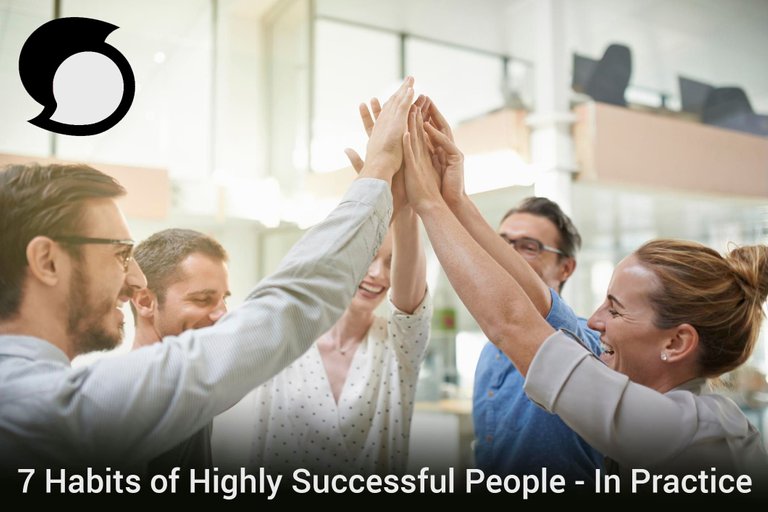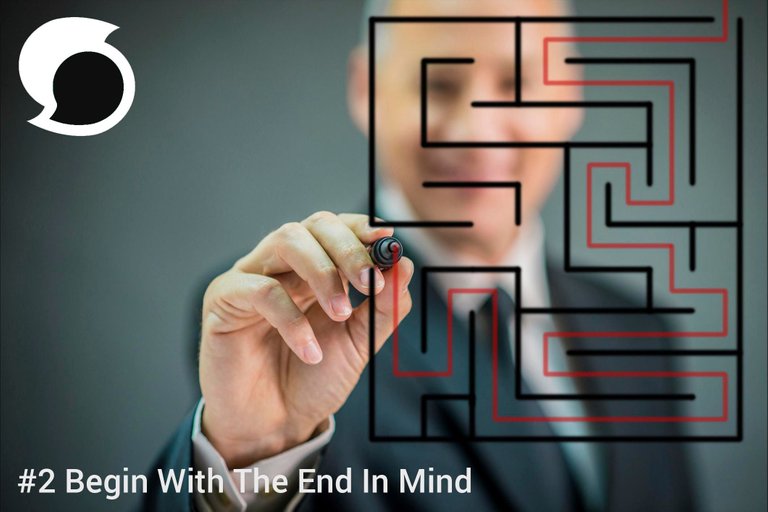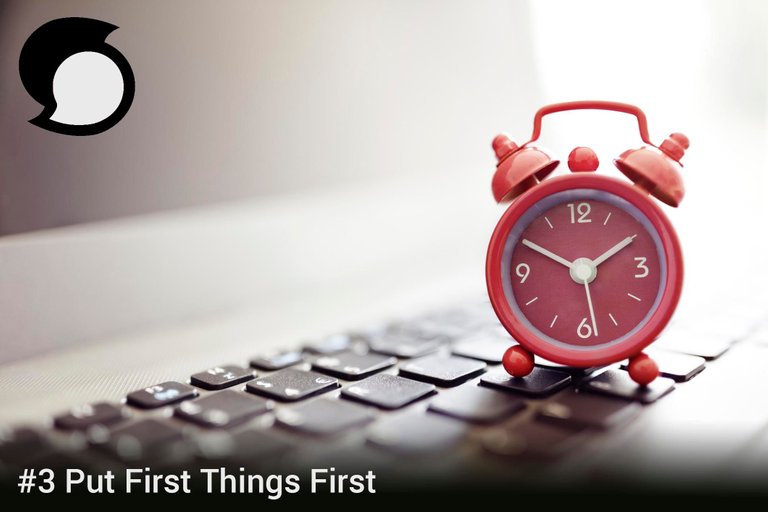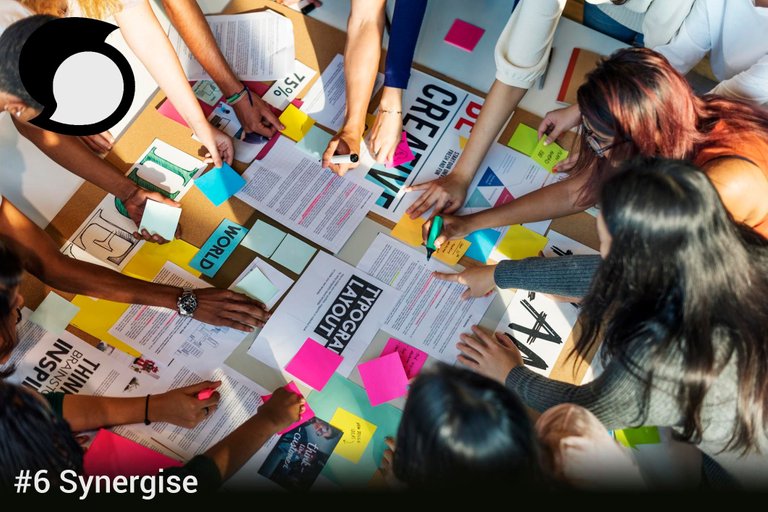
The 7 Habits of Highly Effective People by Stephen Covey has been one of the most influential books I have read (and still do). However, reading something inspiring is one thing, putting it into practice is quite another.
In this post I outline a summary of the 7 habits discussed in the book but with examples of how we have put this into practice in our company.

Covey defines proactivity (and the paradigm shift that comes with it) as exercising your freedom to choose self-awareness, imagination, conscience, or independent will, in between stimulus and response. If you’re unhappy, unsuccessful, etc., it’s because you chose to let something make you that way instead of choosing your own response.
This is not just positive thinking; being proactive means understanding the reality of a situation, but understanding the reality of a situation also means understanding the reality that you can choose your response to your circumstance.
A couple of years ago our company was in a crisis situation. Our product was riddled with bugs, we were well behind on schedule and one of our major shareholders was withholding the next tranche of investment because of this. It would have been easy at that time to fold and move on. However, we decided that we needed to proactively take hold of the situation and really nail the main issues with the product and get our shareholder back on side.
My management team and I locked ourselves in a meeting room for a day to hash out solutions to this crisis. This involved ways of prioritising the issues with the product (see habit 3), liaising with our prospective customers around delivery schedules and getting our main customer to meet with our shareholder to assure them that they were still committed to taking the product. This resulted in us eventually getting the product to market and securing the funding we needed to survive.
We coined this our ‘Apollo’ meeting. For those of you familiar with the Tom Hanks movie Apollo 13, there is a scene where a group of engineers are in a room trying to figure out how to recycle the air for the crew on the damaged space craft. They basically locked themselves in that room until they had a solution.
Our company now has a policy that any staff member can call an ‘Apollo’ meeting if they really need to escalate an issue. This triggers the attention of the whole management team. By doing this early, we have avoided a few crises since then.

Beginning with the end in mind means approaching any role you have in life with your values and directions clear. Because we are self-aware, we can realise when we are acting in a role that isn’t in harmony with our values or isn’t a result of our own proactive design.
Covey states: “The personal power that comes from principle-centred living is the power of a self-aware, knowledgeable, proactive individual, unrestricted by the attitudes, behaviours, and actions of others or by many of the circumstances and environmental influences that limit other people.”
The best way to make sure your life is aligned with your principles (and the best way to track when you get off centre) is to write a personal mission statement. This also applies to business. Have a clear mission statement and state the company values. This will act as a great compass for your organisation and guide you on major strategic decisions going forward.

Effective management means putting first things first, and doing the things that other people don’t want to do.
Covey describes four levels of time management:
Notes and checklists (reducing your cognitive burden in the present).
Calendars and appointment books (looking ahead to better arrange your future time).
Daily planning, by means of goal-setting and prioritization. Most people never get beyond this level.
Categorization of activities and purposeful focus on and/or exclusion of certain ones.
He suggests that we need to operate at this forth level and borrowed the tool for this categorization from Dwight Eisenhower.

An effective time manager spends as much time as possible in quadrant II, doing things that are important before they become urgent: building relationships, long-term planning, preventative maintenance of all types, etc. The more time you spend in this quadrant, the less time you will have to spend in quadrant I. Delegate or otherwise cut out anything in quadrant III or IV
I talked about this in my previous post here
This is possibly the most effective ‘habit’ we have implemented in our company. Along with setting your mission and values, understanding the key objectives and what is most important acts as a great compass and filter for decision making.
We have a large blown version of the above time matrix in every room in our office to remind everyone that they need to have a ‘Quadrant II’ mindset.

This basically boils down to ensuring everyone gets something beneficial out of a deal. There is no point in business reaching an outcome where somebody loses, because ultimately this will have a negative impact on your business, either by directly losing in the deal or indirectly, with a disgruntled employee, contractor, supplier or customer taking action later to make up for their loss.
This could manifest through employees and/or contractors losing motivation, leaving the company or something more malicious such as stealing files or trade secrets. Suppliers could refuse favourable payment terms or perhaps reduce the quality of the product to save costs. Customers could look for other alternatives or refuse to provide references for you for example.
A recent example of this was my Quality Manager leaving New Zealand. For personal reasons she decided to move to Australia. Not ideal for us given her role. However, her experience and cultural fit required us finding a solution that worked for both of us. By going on contract with reduced hours (she had other offers so this worked) and by utilising tools such as Zoom and Slack etc. we were able to keep her on albeit with a slightly different focus to her role. Ultimately this has benefited both parties I think.

Covey implies that it is common for most people to listen not with the intent of understanding, but with the intent of replying. From a business perspective I interpret this as people/companies entering discussions with only their own perspective in mind.
We should try to look at things from other people’s perspective. Understand their concerns and desires and then try to figure out how you can address those whilst benefitting you. This will also lend itself to achieving a win-win outcome as highlighted in point #4.
Last year we had a prospective customer who worked off a one off, upfront pricing model. We worked off a monthly subscription model. There was a stand-off but once we all participated in a half-day workshop the solution presented itself. Their issue was that they were working off a Capital Expenditure budget whilst we were pushing for Operational Expenditure.
Eventually, we agreed to charge them a one-off license fee factoring in a 24 month subscription with a 20% discount. The result was they were able to get internal sign off and we pulled forward 24 months of revenue per active user! Had we stood our ground we wouldn’t have recognised a better pricing model for ourselves going forward.

Synergistic communication, according to Covey, is “opening your mind and heart to new possibilities, new alternatives, new options.” This applies to the classroom, the business world and wherever you could apply openness and communication. It’s all about building cooperation and trust.
We have captured the essence of this in our company through Agile Sprint Planning sessions, where everyone gets to participate and offer suggestions, solutions and questions. This gives you the benefit of addressing a topic or issue from all perspectives of the business and typically results in a better overall outcome.

Covey tells the story of a man who was walking through a forest when he came across a frustrated lumberjack.
The lumberjack was trying to cut down a tree with and was cursing as he laboured in vain.
“What’s the problem?” The man asked.
“My saw’s blunt and won’t cut the tree properly.” The lumberjack responded.
“Why don’t you just sharpen it?”
“Because then I would have to stop sawing.” Said the lumberjack.
“But if you sharpened your saw, you could cut more efficiently and effectively than before.”
“But I don’t have time to stop!” The lumberjack retorted, getting more frustrated.
The man shook his head and kept on walking, leaving the lumberjack to his pointless frustration.
Sometimes you can be working so hard that you forget about re-energising and renewing yourself to sharpen yourself for the tasks in front of you. Some sharpening techniques include studying, reading, planning and resting from your daily work tasks.
This is arguably the second most effective ‘habit’ we have focused on. We addressed this by implementing a ‘Sharpen The Saw’ day at the end of every development sprint followed by a sprint planning day at the beginning of the next sprint. We’ve found this a useful time for everyone to recharge and get a ‘big picture’ view of what we are trying to achieve again.
Conclusion
While it is certainly not a comprehensive framework for personal or business effectiveness, The 7 Habits of Highly Effective People gets many things right, and was certainly worth our management implementing policies and processes centred around these ideas.
There are other ideas and philosophies that we have implemented as well with varying degrees of success. I’ll probably discuss these at some point. However, I would very much like to hear from you if you have read this book and implemented some or all of its principles into your personal or business life. It would be great to know what worked for you and what didn’t.
Take Care,
Alan
Alan Brannigan
Husband, Father, CEO, Entrepreneur, Tech-Geek, Crypto Enthusiast, Believer in Freedom and Liberty
Email: [email protected]
Steemit - @nalabra
Referrals:
This is a great information. So worth reading this.
Thanks @lisaocampo, much appreciated.
Alan thank you for reminding me how much I loved reading 7 Habits of Highly Effective People because five years have passed since I first read it and I am amazed how thoroughly I am practicing the habits in my life now especially compared to when I read it in 2013!
Today most of my time is quality time and every day in what I do I try to help share how I do that and empower as many more of us as possible to have the same opportunity because I am amazed the more quality time I spend the higher the quality of my work is and the less of it I need to do!
I appreciate the chance to read over these 7 habits again because I have hope I will continue practicing each in my life today!
Thanks Jerry, this book has certainly been a big influence on me personally as well as my business. I refer back to it every now and again and I'm sure I'll still be referring to it 5 years from now 😉
Have a great day.
WARNING - The message you received from @alfian is a CONFIRMED SCAM!
DO NOT FOLLOW any instruction and DO NOT CLICK on any link in the comment!
For more information, read this post:
https://steemit.com/steemit/@arcange/anti-phishing-war-the-crooks-continue-their-bashing-campaign
If you find my work to protect you and the community valuable, please consider to upvote this warning or to vote for my witness.
buena información,gracias muchos exitos
Great list! I certainly incorporate those ideas into my life.
#7 is an under rated sneaky Devil that catches up on you if you don't pause to sharpen your saw.
Yes, I find that Sharpening the Saw is critical to success.
những kiến thức tuyệt vời.
cảm ơn bạn
Great advise. Trying to implement similar behavior patterns every day. Some days it is easy, some days not so easy.
I think the main point @marcusantoniu26 is that we keep trying!
@nalabra, thanks for sharing the lessons from this book with us. I read it many years ago and it has stuck with me The habits are very practicable and I must confess it is a game changer.
I encourage everyone to get a copy
I couldn't agree with you more @tolusedove
nice write up man,these are the secret some businessman dont know and they will keep labouring.i like this post!! keep it up!!
Thanks for the positive feedback @teeteelaryor